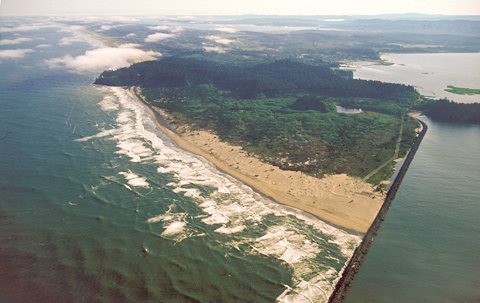Cape Disappointment
View north by northwest
To see labels, point to the image.
© 2000 Airphoto—Jim Wark.
On 18 November 1805, Clark and his ten-man party proceeded southwest along the shore of Baker Bay, at upper right in the photo, passing a popular trading-ship anchorage where they carved their names on trees. Somewhere in that vicinity, Reubin Field killed the first California condor they had seen, which they identified, Sergeant Ordway recorded, as “a verry large turkey buzzard which had white under its wings, and was nine feet from the points of the wings, and 3 feet 10 Inches in length.” They then clambered up onto the narrow peninsula at far right; the tip of Cape Disappointment is beyond the right edge of the photo. The lighthouse which still warns mariners away from the cape was built in 1853-56. Its light can be seen 20 miles out to sea.
Turning northwest again, they climbed McKenzie Head, which was then “a high Seperate bald hill Covered with long corse grass & Seperated from the hight of Country by a Slashey bottom.” Today it’s the dark little bump just above and to right of photo center, surrounded by land that built up during the twentieth century behind the North Jetty, which is that long, dark line of rocks extending up diagonally from the bottom of the picture. Clark was pleased that his men appeared “much Satisfied with their trip beholding with estonishment the high waves dashing against the rocks & this emence ocean.” That awesome view of the sea was the focal point of their ultimate triumph.
The point of land projecting through the surf into the ocean above photo center is North Head—the windiest place on the West Coast, with a record blow of 120 mph. A lighthouse was completed in 1898 as a supplement to the Capt Disappointment light, to guide mariners approaching from the north. Its revolving beam, situated 190 feet above sea level, can be seen from 17 miles away.
Private Whitehouse thought his captains had named Cape Disappointment “on account of not finding Vessells there,” but it had received the name years earlier. For generations, sailors had sought the entrance to the “Great River of the West.” In 1788 a British trader named John Meares thought he had found it, but, unable to cross the sandy bar, he concluded that it was not the estuary of a river but just a bay. He named it Deception, and the cape on its north side, Disappointment. Four years later Robert Gray, a trader from Boston, found the river’s narrow channel and sailed his ship Columbia Rediviva across the bar, discovering that this body of water was indeed a river, which he named after his ship.
From Discovering Lewis & Clark from the Air
Photography by Jim Wark
Text by Joseph Mussulman
Reproduced by permission of Mountain Press

